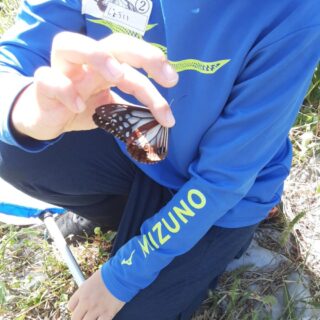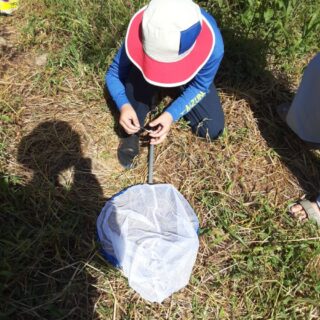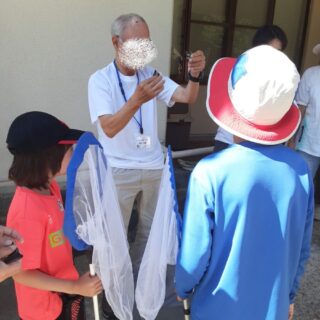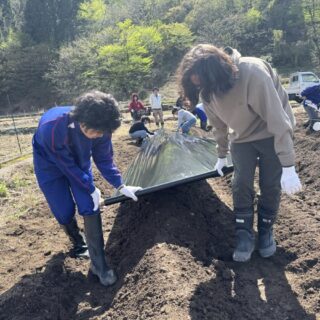Local Community
地域連携
 こんにちは。白山麓キャンパスで英語を教えているジェームス・テイラーです。
こんにちは。白山麓キャンパスで英語を教えているジェームス・テイラーです。
白山麓キャンパスで暮らし、働くことの素晴らしい点の一つは、周囲に豊な自然があることです。毎日色んな面白い生き物を間近で見られます。例えば、毎年9月下旬に瀬戸地域に現れる蝶のアサギマダラです。
アサギマダラ(英語名:Chestnut tiger butterfly)は面白い蝶です。なぜかというと、毎年とても長い旅をするからです。長い旅の途中で立ち寄る場所の一つが瀬戸で、白山麓キャンパスからほんの数十メートルの場所にやって来ます。
地元の方々は、蝶を呼び寄せるために、使われていない畑にフジバカマを植えています(白山麓キャンパス向かいの「道の駅 瀬女」付近)。この場所は「アサギマダラ空の駅・白山」と呼ばれていて、アサギマダラファンクラブ白山は、毎年ここでマーキング調査をしています。2025年9月27日(土)、私は息子と一緒に蝶のマーキング調査体験会に参加しました(主催:アサギマダラファンクラブ白山、尾口コミュニティセンター、白山麓里山活性化協議会)。
まず、アサギマダラファンクラブ白山の中村 明男さんのお話しを聞きました。中村さんは、蝶のライフサイクルや移動の習性について説明してくれました。また、例として自分で捕まえてマーキングしたアサギマダラを見せてくれた後、マーキングの仕方を説明・実演してくれました。
蝶は捕まえられると、死んだふりをするので、羽に文字が書きやすくなります。フェルトペンを使って、捕まえた場所(私たちの場合は「白山」)、日付(9/27)、自分の名前又はイニシャル、そして捕まえた順番を示す番号を羽の白いところに丁寧に書きます。
また、この情報を紙にも記録し、中村さんが他の地域にあるアサギマダラファンクラブとオンラインで共有できるようにします。さらに、私たちがマーキングした蝶を誰かが捕まえた場合に、連絡をもらえるように連絡先も記入します。
過去には、瀬戸でマーキングされたアサギマダラが、四国、九州、沖縄、さらには台湾でも見つけられたことがあります(瀬戸から台湾までは、2,000キロ以上も離れています!)。天候の変化により、近年は蝶の数が少なかったのですが、息子は3匹捕まえてマーキングすることができました。
その3匹の蝶たちはどこまで飛んでいくのかな。
ジェームス・テイラー
 Hello everyone. I’m James Taylor, one of the English teachers at ICT’s Hakusanroku Campus.
Hello everyone. I’m James Taylor, one of the English teachers at ICT’s Hakusanroku Campus.
One of the best things about living and working at Hakusanroku Campus is the abundance of nature that surrounds us. We get to see a wide variety of interesting creatures up close. An example of this is the Chestnut tiger butterflies that appear in the Seto area at the end of every September.
Chestnut tiger butterflies are known in Japanese as “Asagimadara”. They are an interesting type of butterfly because they migrate very long distances, and one of the places they stop en route is just a few dozen metres down the road from our school. To encourage the butterflies, local residents and community groups plant Boneset (“Fujibakama” in Japanese) in disused allotments – like those near the Roadside Station Sena opposite ICT -- and call it the “ASAGIMADARA SORANOEKI (Sky Station)・HAKUSAN”. The Asagimadara Fan Club Hakusan conducts a marking survey here every year. On Saturday, September 27th, 2025, my son and I participated in a butterfly marking event organised by the Asagimadara Fan Club, Oguchi Community Centre, and the Hakusanroku Satoyama Revitalisation Council.
First, we listened to a lecture by Mr. Nakamura of the Asagimadara Fan Club Hakusan, who told us about the butterflies’ life cycle and migratory behaviour. Mr. Nakamura showed us examples of Chestnut tiger butterflies that he’d caught and marked, then gave an explanation and demonstration of how to mark them. Once they’ve been caught, the butterflies play dead, so it’s easy to write on the white part of their wings. Using a felt tip pen, you have to carefully write the location (Hakusan or 白山 for us), the date (9/27), then our name or initials and a number to denote the order in which we caught and marked the butterfly. We also had to write all this information on a paper so that Mr. Nakamura could enter it online and share it with other Asagimadara Fan Clubs in other regions of Japan. We also had to write our contact details, so that if someone catches a butterfly we’ve marked, we can be contacted and told where it got to.
In previous years, Chestnut tiger butterflies that have been marked in Seto have later been found in places like Shikoku, Kyushu, Okinawa, and even Taiwan – that’s over 2,000 kilometres from Seto. The changes in the weather have meant that last year and this year there weren’t so many butterflies, but my son managed to catch and mark three.
I wonder how far they’ll travel.
James Taylor
Related Articles on Last Year’s ICT Chestnut Tiger Butterfly Marking Event
 こんにちは。校長の鹿田 正昭です。
こんにちは。校長の鹿田 正昭です。
 2025年4月24日(木)、今回で3回目の参加となる、エンジニアリングデザインⅡ(2年生)「紅はるか」の苗植えをお手伝いしました。今回は金沢キャンパスで会議があったため、会議終了後に白山麓キャンパスに移動し、到着した頃にはすでに畝が完成し、植え付けが始まっていました。今年は西側から2列目を半分ほど植えました。今冬は雪が多かったため土がかなり湿っている感じでしたが、この方が作業を進めやすいと感じました。
2025年4月24日(木)、今回で3回目の参加となる、エンジニアリングデザインⅡ(2年生)「紅はるか」の苗植えをお手伝いしました。今回は金沢キャンパスで会議があったため、会議終了後に白山麓キャンパスに移動し、到着した頃にはすでに畝が完成し、植え付けが始まっていました。今年は西側から2列目を半分ほど植えました。今冬は雪が多かったため土がかなり湿っている感じでしたが、この方が作業を進めやすいと感じました。
苗植えは3回目となりましたが、慣れてきたとはいえやはり自分の植えた苗が収穫時にうまく育っているか気になります。一昨年は雨が多かったせいか、あまり大きな芋の収穫はできませんでした。昨年は天候も良く、適度な雨だったため大きな芋が育ちました。今年も昨年同様な出来具合を期待したいと思います。
2年生全員とエンジニアリングデザインⅡ担当の先生方、ラーニングメンターのアブワン兄妹も参加して午後4時前に苗付けを完了しました。そして電気柵の設置や獣害対策が施され、今年も昨年に引き続いての豊作を期待したいと思います。
本校では11月1日(土)、2日(日)にオープンキャンパスを開催します。これに合わせて恒例の焼き芋販売が「道の駅瀬女」で行われる予定です。お時間があれば、ぜひ「道の駅瀬女」まで足を伸ばしてみてください。
オープンキャンパス詳細はこちら
鹿田 正昭
Hello. I am Masaaki Shikada, ICT President.

On Thursday, April 24th, 2025, I helped plant Engineering Design II's "Kosen Beniharuka" seedlings for the third time. This time, I had a meeting at Kanazawa Campus, so I couldn’t travel to Hakusanroku Campus until after the meeting ended. By the time I arrived, the ridges had already been prepared and the planting had begun. This year I planted the second row from the west side. The soil was quite wet this winter due to the heavy snowfall, but I felt this made the work easier.
This is the third time I have planted seedlings, and although I am getting used to it, I still worry about whether the seedlings I planted will grow well. The year before last, the potatoes did not grow very large, probably because it rained a lot. Last year, good weather and moderate rainfall resulted in large potatoes. We expect this year's crop to be as good as last years.
All 2nd year students, Engineering Design II teachers, and Learning Mentors Domyson Abuan sensei and Sharmee Abuan sensei joined us to complete the seedling planting before 16:00. Then electric fences were installed and measures were taken to prevent damage from animals. We hope for another good harvest this year, following on from last year.
Our school will hold an open campus on Saturday, November 1st and Sunday, November 2nd. In conjunction with this event, the annual baked sweet potato sale will be held at the Sena Road Station. If you have time, please visit the Sena Road Station and try some potatoes!
Click here for more details about Open Campus
Masaaki Shikada
 こんにちは、財務部の泉屋 利吉です。
こんにちは、財務部の泉屋 利吉です。
2025年3月1日(土)19:00、まだ雪が多く残るこの東二口歴史民俗資料館には、続々と村の方々が集まる姿がありました。
この東二口文弥人形浄瑠璃は350余年も続く、国指定重要無形民俗文化財であり、京都からこの地にやってきた伝統文化です。350年もの間受け継がれてきたと聞くだけで、その大切さを感じますが、「でくの舞」を披露する演者や、その舞を鑑賞する人々も、「この“でくの舞”を見ないと一年が始まらない」と声を揃えて言っていたのが印象的でした。
冬の寒い農閑期の時期の一つの楽しみにとして、現代まで受け継がれてきたものですが、文楽とはまた異なり、文弥節と呼ばれる独特の語り口で物語が進んでいきます。
初めて聞く人は内容が良く分からないと思いますが、演目が始まる前に、紙芝居があり、演目の内容を丁寧に教えてくれます。私もこの紙芝居がなかったら正直ついていけなかったと思いました。
この東二口に伝わる文弥人形浄瑠璃ですが、近年継承する人たちも高齢化が進み、伝承が難しくなっています。今は十数名ででくの舞を披露していますが、おそらく裏方作業も含め、一人何役もこなしているのではないかと思います。
そのような中、国際高専の松下 臣仁教授が5年前からこの人形浄瑠璃の演者として参加し、毎年公演会に参加しています。その他金沢工業大学の職員や学生などもでくの舞の保存会へ参加し、ベテランの先輩方から、でくの舞の舞い方を習いつつ、東二口の伝統と文化を受け継ごうとしています。
「でくの舞」に使われる人形は、「かしら」「心棒」「肩板」「手」の4つのパーツから出来ており、一人で1体の人形を操ります。文楽では3人で1体の人形を操りますが、「でくの舞」で使われる人形はシンプルではありますが、扱うことが出来るまでには相当な修練が要求されます。また、人形と一体となって、3歩前進し2歩後退する舞い手の足運びが独特であり、床を足で叩きながら、リズミカルに舞を披露します。これが、舞踊的な感じを生み出し、「でくの舞」と呼ばれる所以となりました。まさに、人形を操るのではなく、逆に人形と一体となって舞い手が操られる感覚が要求されるとの事で、その奥深さを感じずにはいられません。
350余年もの間、人々から愛され続けてきた人形浄瑠璃が、この白山市に残っている事も感動的ですが、その伝統を受け継いでいく方々の努力や思いは計り知れないものがあると感じました。演目が披露された東二口歴史民俗資料館の舞台は、多くの人は入れませんが、昔ながらの雰囲気が残る場所であり、人形浄瑠璃を間近に見ることが出来ます。
松下教授のでくの舞を見ながら、ふと300年前の世界にタイムスリップしたような気分にさせられました。でくの舞の「泣き節」と呼ばれる文弥節とリズミカルに床を蹴る舞い手の足運びの音が今も頭に余韻として残っています。
-
Audience watching the performance up close演舞を間近に鑑賞する聴衆
-
Photo of Omihito sensei and ICT student国際高専の学生と一緒に写る松下教授
-
Omihito sensei becomes one with the doll人形と一体となる松下教授(左)
-
Higashi Futakuchi Local History Museum,白山市東二口歴史民俗資料館
-
Puppets dancing on the stage舞台を所狭しと人形が舞う
泉屋 利吉
 Hello, this is Rikichi Izumiya from Finance Division.
Hello, this is Rikichi Izumiya from Finance Division.
At 7:00 P.M., on Saturday, March 1st, 2025, people from the villages surrounding Higashi Futakuchi gathered at the Higashi Futakuchi Local History Museum, despite there still being a lot of snow on the ground.
This annual Higashi Futakuchi Bunya Ningyo Joruri performance has continued for more than 350 years and is a nationally designated Important Intangible Folk Cultural Property, a traditional culture that came to this area from Kyoto. Just hearing that it has been passed down for 350 years makes me appreciate its significance. What left a strong impression on me was that both the performers of the Deguno Mai and those who watched it all said in unison, "Every year cannot begin without seeing this Deguno Mai."
This tradition has been passed down to the present day as one of the high points of the cold, agricultural off-season in winter. Unlike Bunraku, however, the story unfolds in a unique narrative style called Bunya bushi.
For those seeing it for the first time, the story may be difficult to understand. However, before the performance begins, a kamishibai (picture-story show) is presented, carefully explaining the content of the performance. Honestly, I think I would have had a hard time keeping up without it.
This Bunya Ningyo Joruri, passed down in Higashi Futakuchi, is facing challenges in preservation as the people inheriting it are aging. Currently, a little over ten performers present the Deguno Mai, but I assume that, including backstage roles, each person is taking on multiple responsibilities.
Amid these challenges, Omihito Matsushita sensei from ICT has been participating as a performer in this Ningyo Joruri for the past five years, taking part in the annual performances. Additionally, faculty members and students from KIT have joined the Deguno Mai preservation society, learning the dance from experienced elder members while striving to inherit the traditions and culture of Higashi Futakuchi.
The puppets used in Dekunomai consist of four parts: the Kashira (head), Shinbo (central rod), Kataban (shoulder board) and Te (hands). Each puppet is operated by a single performer. Although the puppets used in Deguno Mai are relatively simple in structure, mastering their manipulation demands considerable training.
Additionally, the performers move in a distinctive manner, taking three steps forward and two steps back, while rhythmically striking the floor with their feet as they dance. This unique footwork creates a dance-like impression, which is why it came to be known as Deguno Mai. Rather than simply controlling the puppet, performers must become one with it—almost as if they are being guided by the puppet itself. This profound technique highlights the depth and artistry of the performance, leaving a lasting impression.
It is truly moving that this Ningyo Joruri, which has been cherished by people for over 350 years, still remains in Hakusan City. At the same time, I feel that the efforts and dedication of those who continue to uphold this tradition are beyond measure. The performance took place on the stage of the Higashi Futakuchi Local History Museum. While the space cannot accommodate a large audience, it retains the atmosphere of the past, allowing visitors to experience Ningyo Joruri up close.
Watching Omihito sensei perform Deguno Mai, I suddenly felt as if I had traveled back in time to the world of 300 years ago. The lingering echoes of the Bunya bushi style, known as the "Naki-bushi" (weeping melody), along with the rhythmic sound of the performers’ footwork striking the floor, still resonate in my mind.
-
Audience watching the performance up close演舞を間近に鑑賞する聴衆
-
Photo of Omihito sensei and ICT student国際高専の学生と一緒に写る松下教授
-
Omihito sensei becomes one with the doll人形と一体となる松下教授(左)
-
Higashi Futakuchi Local History Museum,白山市東二口歴史民俗資料館
-
Puppets dancing on the stage舞台を所狭しと人形が舞う
Rikichi Izumiya

こんにちは。英語科目担当のジェームス・テイラーです。
2024年12月にICT白山麓キャンパスの近く、白山市尾口で開かれたクリスマスイベントを紹介したいと思います。
まずは12月10日(火)の夕方、尾口地区社会福祉協議会の職員の方から子供がいる家庭にクリスマスケーキが配られました。職員の方のうち1人はサンタクロースの格好をしてケーキを届けに来てくれました。僕の家にもサンタ、雪だるま、トナカイの3つのケーキが届きました。子供たちは雪だるまとトナカイ、僕はサンタのケーキを頂きました。
そして、12月18日(水)に尾口コミュニティセンターで恒例のイングリッシュカフェのクリスマスパーティーが開かれました。今回の参加者は尾口地区、吉野谷地区、白峰地区から子供11人と大人4人でした。最初にみんなでツリーに飾り付けをし、出来上がったツリーと一緒に写真撮影をしました。パーティーの始まる2時間前から尾口コミュニティセンターと白峰コミュニティセンターの職員の方々がイギリスのレシピを使ってパンケーキを焼いてくださったので、ツリーの飾り付けの後は、一人一枚ずつパンケーキのデコレーションをしました。
デコレーションのために、スタッフの方がクリームや果物などを準備してくれました。みんなが食べている間、僕は英語の絵本の読み聞かせをしました。初めに「ゆきのひ」(作:エズラ・ジャック・キーツ)を読み、そしてみんなが食べ終わった後はもう冊「ハトにうんてんさせないで。」(作:モー・ウィレムズ)を読みました。この絵本は夏に白峰の子供たちに読んだ時に人気だったのですが、今回も大人気な絵本となりました!
次にみんなでゲームをしました。最初にビンゴをして、それから「トナカイに赤い鼻をつけて!」というゲームをしました。このゲームは、目を閉じてからトナカイの絵に赤い磁石で作られた鼻を付けるというゲームです。トナカイの鼻に一番近く磁石を付けた人が勝ちです。大人より子供たちの方が上手く付けることができました!最後にサンタクロースが登場し、みんなプレゼントを受け取りました。
今回もまた、尾口コミュニティセンターと白峰コミュニティセンターの職員の方々が一生懸命準備してくださったおかげで、とても楽しいイベントを開催することができました。ありがとうございました!
ジェームス・テイラー
 Hello everyone. I’m James Taylor, one of the English teachers at Hakusanroku Campus. I’d like to tell you about a couple of Christmas events that took place in the neighbourhood during December, 2024.
Hello everyone. I’m James Taylor, one of the English teachers at Hakusanroku Campus. I’d like to tell you about a couple of Christmas events that took place in the neighbourhood during December, 2024.
First, on Tuesday, December 10th, the workers from the Oguchi Social Welfare Council – one of whom was dressed as Father Christmas – delivered Christmas cakes to every household with children. This year we got a snowman, a Santa, and a reindeer. My children ate the snowman and reindeer, and I had the Santa.
Then, on Wednesday, December 18th, I went to Oguchi Community Centre, which is just down the road from ICT, to participate in the annual English Café Christmas party. This year we had 11 children and 4 adults from the Oguchi, Yoshino, and Shiramine areas. We started the party by decorating the tree and taking pictures when it was finished. Earlier in the afternoon, the staff from the Oguchi and Shiramine Community Centres spent hours making pancakes using a British recipe. After we’d finished decorating the tree, everybody was given a pancake and some ingredients to decorate it with, like cream, fruit, and sprinkles. While the guests were eating, I read them a story: ‘The Snowy Day’ by Ezra Jack Keats. When everyone had finished eating, I read ‘Don’t Let the Pigeon Drive the Bus’ by Mo Willems, which was as popular this time as it had been in Shiramine in the summer!
We played bingo and a game called Stick the Nose on Rudolph, where players had to stick a red magnet on a picture of Rudolph without looking. The children got much closer to the right spot than the adults! The party ended with a visit from Father Christmas, who brought a small present for everyone.
As ever, the staff from the Oguchi and Shiramine Community Centres worked really hard organising the event and preparing bingo prizes, presents, and food and drink for the party. I always appreciate their efforts.
James Taylor
こんにちは、学生主事の小髙 有普です。今回は学生が地域の企画運営に参加した内容について紹介したいと思います。
2024年9月23日(月)の祝日に、本校前の畑において、アサギマダラ(※)のマーキングイベントが開催されました。
※アサギマダラとは、あさぎ色(薄い水色)をしたまだら模様の翅(はね)から名前がついた蝶々で、海を渡って数千の長距離移動をする蝶々として知られています。その移動状況調査の為、鱗粉の少ないあさぎ色の部分に日付と捕獲場所が分かるよう油性ペンでマーキングされることが行われています。フジバカマなどキク科の花を好んで集まり、その蜜に含まれている毒が繁殖や身を守るうえで用いられていると言われています。また、アニメ「鬼滅の刃」に登場するキャラクターのモデルになっているとも言われています。
昨年度のアサギマダラのマーキングイベントについてはこちら
2年の学生たちは、辰口まちづくり協議会、白山ろく里山活性化協議会、アサギマダラファンクラブが運営するイベントに協力する形で参加しました。白山麓キャンパスの前の休耕田では、アサギマダラが集まるように、フジバカマの栽培が行われています。エンジニアリングデザイン科目において、そこに飛来するアサギマダラという環境資源を活かすため、アグリビジネス班の学生たちが、今年度の4月から企画構想を始め、学生らしい視点による創造で地域活性に挑みました。
学生たちは、地域住民とそうでない方がイベントを通じて継続的に交流することを目標とし、参加するすべての人が思い出に残るように、企画運営の中に細かな工夫を凝らしました。
-
Advertising at Sena Roadside Station宣伝活動(道の駅 瀬女に掲示)
-
Lecture about Marking Asagimadaraマーキング講習会
-
Marking Asagimadaraマーキングの様子
フォトスポットの設置
アサギマダラを見に来てくれたすべての人のために設置したフォトスポットでは、多くの人が撮影していました。学生たちが設けたフォトスポットで思い出の写真を撮っている姿を見ると嬉しく思いましたし、記念を残したい気持ちに応えることができたのではないかと思います。
小学生対象のグッズ作り
マーキングイベントへ参加した小学生たちは、午後から2年生の指導のもと、オリジナルグッズを作成しました。グッズはアサギマダラをイメージしたヘアグリップやマグネットで、小学生たちは配色や配置を工夫しながら装飾を加えて仕上げていました。
グッズ販売、ものづくり体験企画
道の駅に立ち寄り、今回のイベント情報を得てアサギマダラを観察に来られた方には、アサギマダラの生態が記された図鑑付きのキーホルダーをカプセルトイで販売しました。また、記念としてキーホルダーをレーザーカッターで制作するものづくり体験教室を実施するなど、国際高専生ならではの企画を試みました。
学生たちは地域住民と交流人口の関わり方について考え企画を実施しました。その後の学生たちの振り返りでは、次の開催がより充実した企画となるための意見が多くありました。次の年に引き継ぐ学生たちは今回の意見を汲み取り、さらに充実したイベント開催が期待できます。
今年は暑さの影響か、アサギマダラの飛来数はとても少ないものでしたが、来年は多くのアサギマダラが飛来することを願っています。
小髙 有普
Hello, this is Arihiro Kodaka, Dean of Student Affairs. This time, I would like to write about the details of the students' participation in community planning and management
On Monday, September 23rd, 2024 (Autumnal Equinox Day), a marking event for the Asagimadara (*) (Chestnut Tiger Butterfly) was held in the field across from Hakusanroku Campus.
(*) The Asagimadara is a butterfly named for its wings, which are light blue with mottled patterns. It is a butterfly that migrates several thousand kilometers across the ocean. In order to track their migration patterns, the less powdery light blue parts of their wings are marked with the date and capture location using a permanent marker. The Asagimadara are attracted to flowers in the Asteraceae family, such as the Fujibakama flower (boneset) and the toxins in the nectar help them with reproduction and protection. Additionally, one of the characters in the anime Demon Slayer is inspired by this butterfly.
For information on last year’s Asagimadara marking event.
2nd year students supported an event organized by the Tatsunokuchi Community Development Council, Hakusanroku Satoyama Revitalization Council, and the Asagimadara Fan Club. In a fallow field across from Hakusanroku Campus, fujibakama flowers are cultivated to attract the Asagimadara. In the Engineering Design class, the Agribusiness team of students started planning in April of this year, aiming to utilize Asagimadara as an environmental resource to boost the local community. Through creative ideas and a fresh, student-oriented perspective, they tackled the challenge of revitalizing the area.
The students aimed to create continuous interactions between local residents and non-residents through the event, ensuring that everyone involved would have lasting memories. They put great effort into the planning and organization, incorporating many thoughtful details to achieve this goal.
-
Advertising at Sena Roadside Station宣伝活動(道の駅 瀬女に掲示)
-
Lecture about Marking Asagimadaraマーキング講習会
-
Marking Asagimadaraマーキングの様子
Photo Spot
A photo spot created by students was set up for everyone who came to see the Asagimadara, and many people took pictures there. I was happy to see visitors taking memorable photos at the photo spot, and I believe that we were able to respond to their desire to preserve their memories.
Making Goods with Elementary School Students
Elementary school students who participated in the marking event spent the afternoon making original goods under the guidance of ICT 2nd year students. The goods were hair clips and magnets with Asagimadara images, and the elementary school students added decorations and finishing touches by devising color schemes and decorations.
Merchandise Sales and Hands-on Crafting Experience Activities.
For those who stopped by the Sena Roadside Station, learned about this event, and observed Asagimadara, students sold a capsule toy key chain with an illustrated book describing the ecology of the Asagimadara. Additionally, a hands-on workshop was held where participants could use a laser utter to create their own keychains as a keepsake. These activities were part of a unique initiative by ICT students.
The students thought about how local residents and the visitors could be involved in the project and implemented it. Afterwards, the students reflected on the event and voiced many opinions about how to make the next event even more fulfilling. The students who will take over in the next year are expected to take this feedback into account and make the event better.
This year, perhaps due to the hot weather, the number of Asagimadara was very small, but I hope that next year many more Asagimadara will visit.



















































